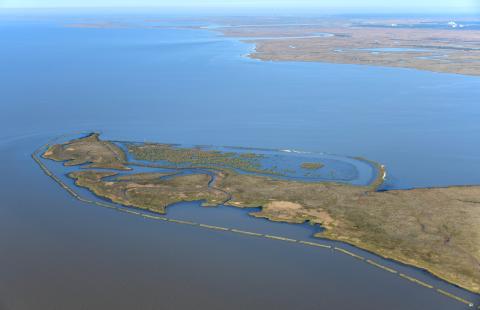Hancock County Marsh Living Shoreline, one of the Mississippi Trustee Implementation Group’s wetlands, coastal, and nearshore habitats restoration projects, received international recognition at the 35th PIANC World Congress. PIANC is the World Association for Waterborne Transport Infrastructure and awards a variety of honors at its annual congress, including the Working with Nature Award. The Mississippi Department of Environmental Quality (MDEQ) was awarded second place worldwide for its efforts to protect and restore the Hancock County Coastal Preserve, the largest contiguous salt marsh in Mississippi.
Working with Nature, according to PIANC, is an international initiative to promote a proactive, integrated approach to sustainable navigation infrastructure projects that delivers mutually beneficial, ‘win-win’ solutions. Other honorees in the Working with Nature category were projects in Spain and Brazil.
The project has six construction phases. The first three phases involved the construction of six miles of breakwaters to decrease incoming wave energy and protect the existing marsh complex. The project is exceeding anticipated restoration benefits. The area has historically suffered shoreline erosion at a rate of 6 to 10 feet per year. Since completion of the existing breakwater structures, the project has helped slow and even reverse land loss. Despite 13 tropical storms directly impacting the project area since completion of the breakwaters in 2018, some areas protected by the breakwater have gained an additional 1.5 to 4 feet of land.
The fourth phase included a 46-acre oyster reef constructed with limestone cultch in Heron Bay, providing vital habitat for oysters and other marine life. The most recent reef monitoring data indicate that the average density of bivalves (approximately half of which are oysters) exceeded project goals. The ongoing fifth phase of the project includes constructing new marsh. The 46-acre marsh beneficially utilized dredged material from Port Bienville and the Pearl River and is scheduled to receive additional dredge sediments from Bayou Caddy.
The sixth phase of the Living Shoreline Project will include construction of approximately two more miles of living shoreline. Funding for this project included Deepwater Horizon Natural Resource Damage Assessment via the Mississippi Trustee Implementation Group and RESTORE Act funding totaling $65.5 million. Co-Implementing Trustees for this project are MDEQ and the National Oceanic and Atmospheric Administration (NOAA).
Watch this informational video for a glimpse of the Hancock County Marsh and Living Shoreline Project.
We also send updates out via email. If you haven't already, please take the opportunity to sign up for e-mail updates today to receive the latest news from all the Deepwater Horizon Trustees.


